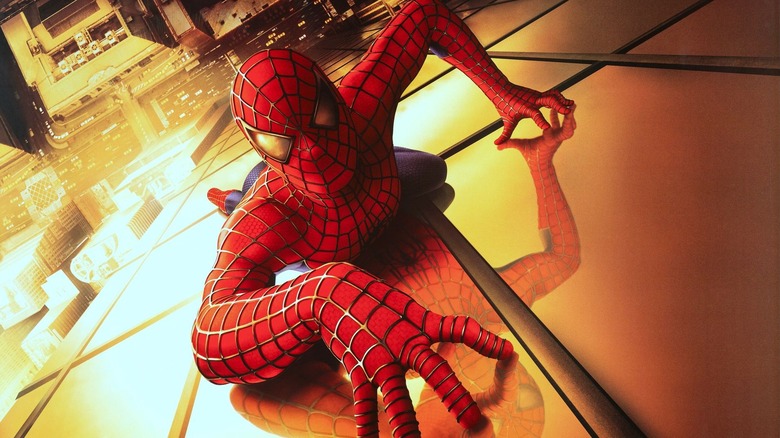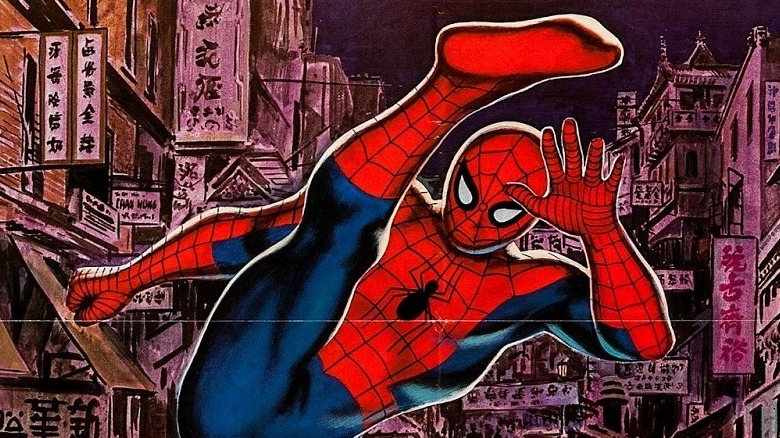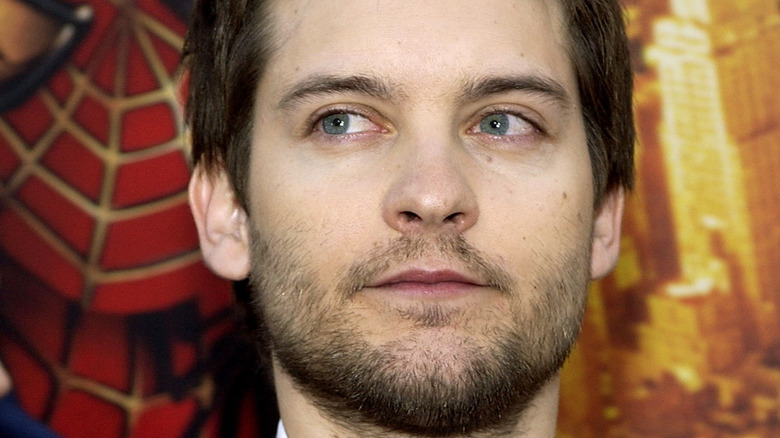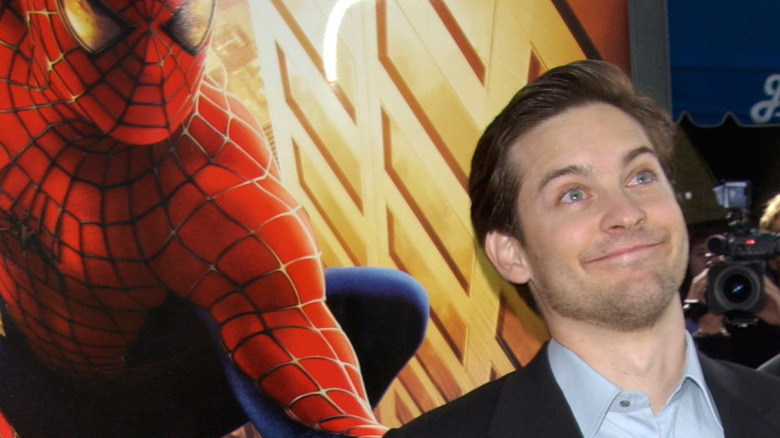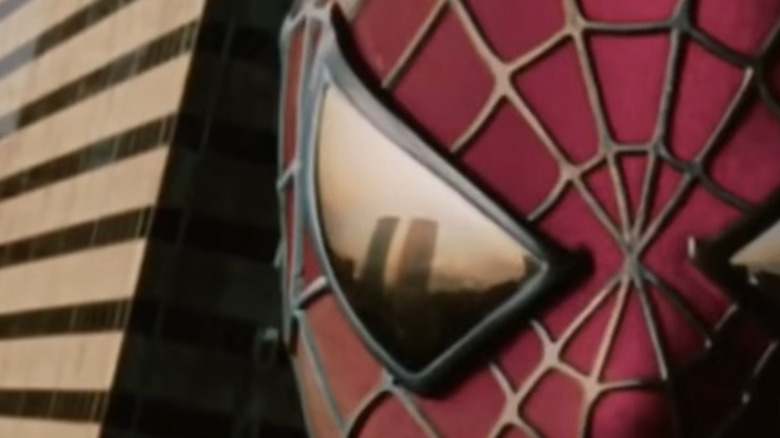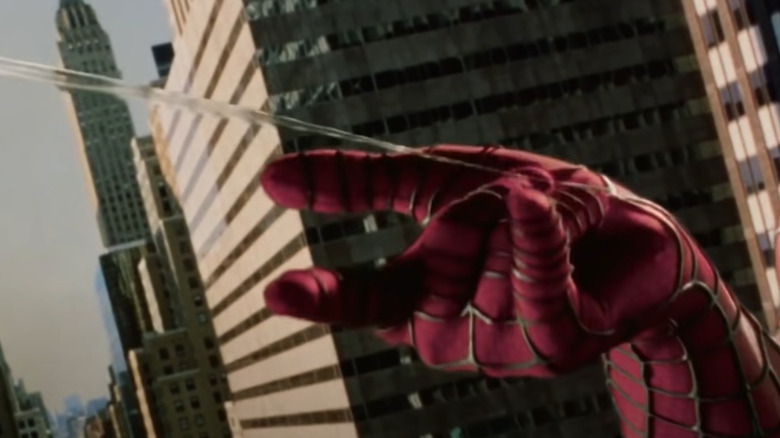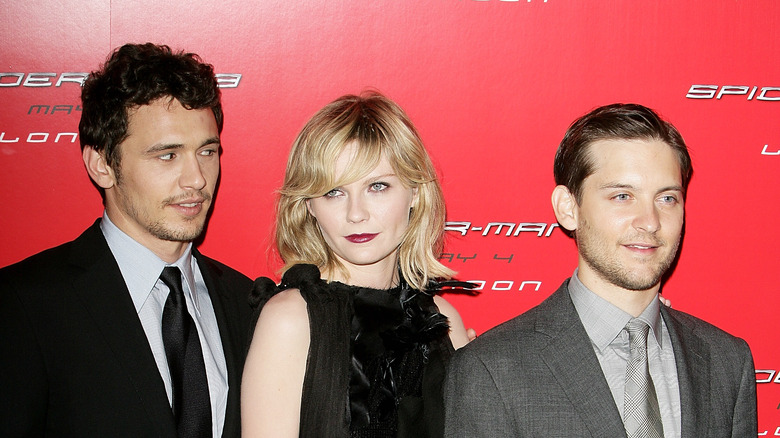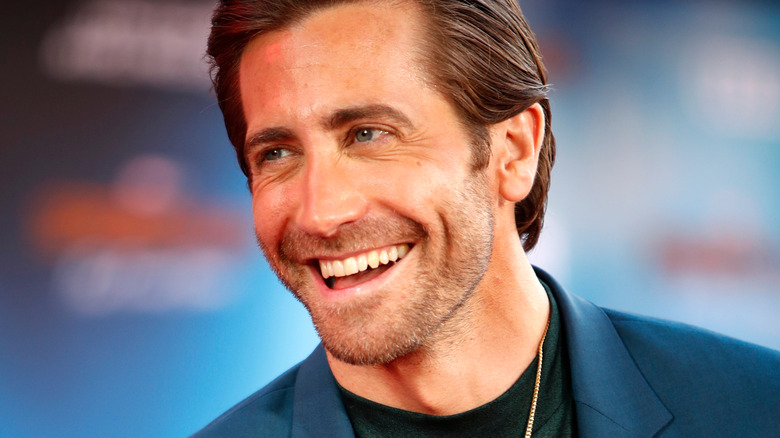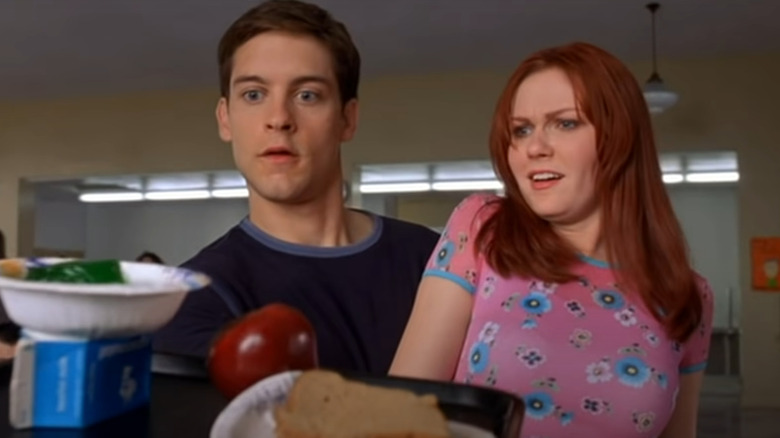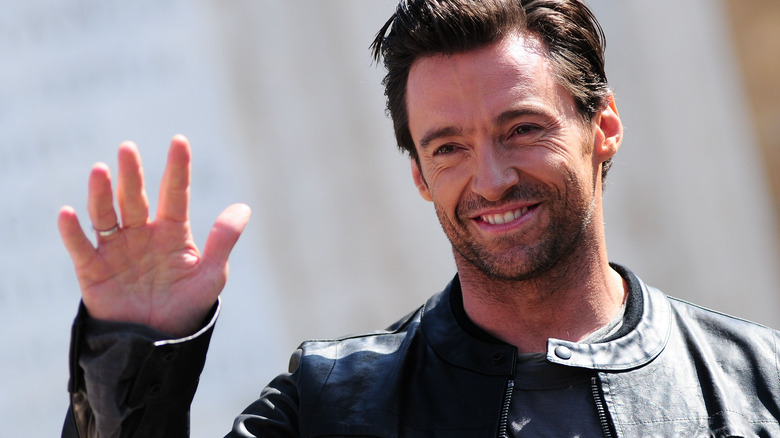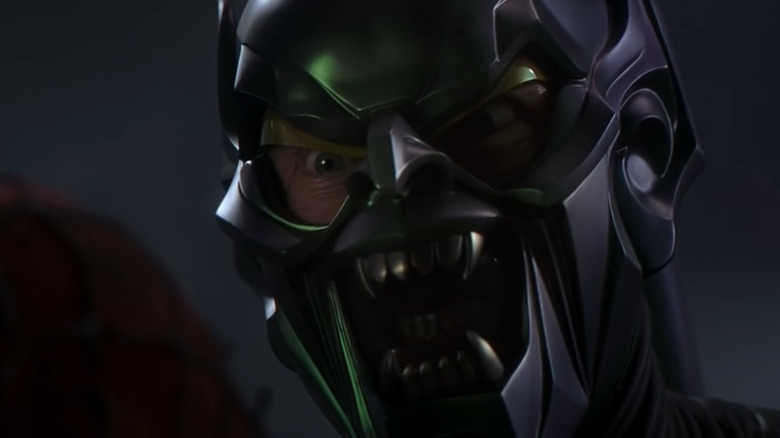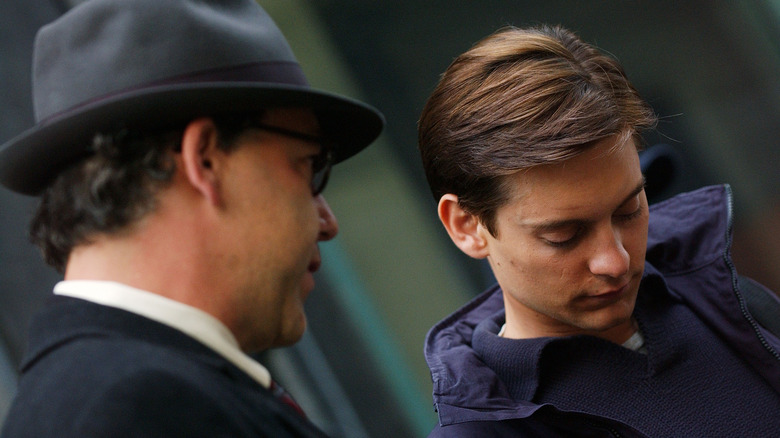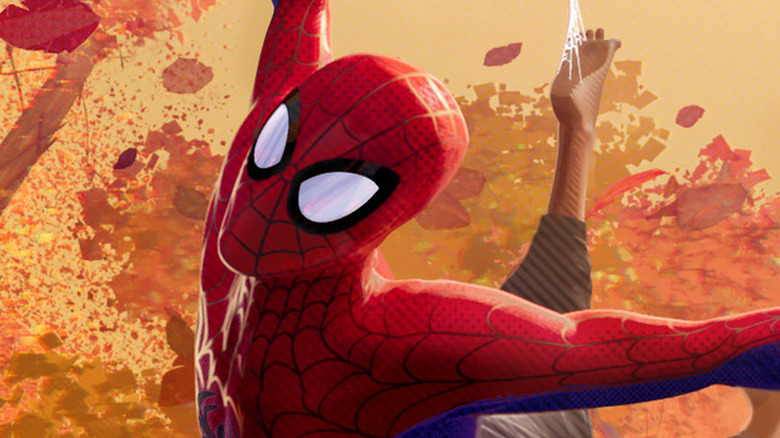What You Don't Know About Tobey Maguire's Spider-Man
The unprecedented success of the Marvel Cinematic Universe proves that there is a market for films based on superhero comic book properties. However, one can argue that Marvel Studios would not have been able to pull off this feat if it weren't for the smaller, self-contained Marvel movies made by other studios in the early 2000s. And at the forefront of these films — and for quite some time, the most commercially successful among them — was Sam Raimi's "Spider-Man" trilogy, which starred Tobey Maguire as the titular protagonist.
Technically, Maguire wasn't the first person to play Peter Parker/Spider-Man in a live-action film. That honor goes to Nicholas Hammond, who also portrayed the webslinger in Spider-Man's 1978 television series. However, Maguire's take on the wall-crawling superhero left an incredible mark on both the character and the superhero movie genre as a whole, with an entire generation of fans growing up while recognizing him as "their" Spider-Man.
That said, things weren't always smooth sailing (or perhaps, swinging) behind the scenes. The road to Maguire's version of Spider-Man was paved with over two decades' worth of failure — and despite its commercial and critical success, the first "true" Spider-Man movie trilogy was not without its share of challenges and difficulties.
For decades, Spider-Man was in development hell
Spider-Man's first foray into live-action cinema came in the form of three movies released outside of the United States, all of which were spin-offs of the 1977 TV show "The Amazing Spider-Man." The first film, simply called "Spider-Man," was actually the show's feature-length pilot. Meanwhile, its sequels — 1978's "Spider-Man Strikes Back" and 1981's "Spider-Man: The Dragon's Challenge" — were merely TV episodes stitched together.
Thus began Spider-Man's long, bitter battle toward a proper silver-screen adaptation (via IGN). Numerous studios threw their hats in the ring from 1977 to 1999, including Cannon Films, Carolco Pictures, and MGM. Ultimately, it was the latter's deal with Sony that helped the webslinger fulfill his cinematic destiny. In exchange for the rights to James Bond, MGM gave Columbia Pictures (under Sony Entertainment) the Spider-Man rights. Interestingly, filmmaker James Cameron came close to becoming the director of the first "true" Spider-Man film. An early 1990s "scriptment" that bore his name revealed that radically reimagined versions of classic Spider-Man foes Sandman and Electro were intended to be the main villains of the film (via Cinema Blend).
Ultimately, Sony gave the directorial reins to Sam Raimi, who at the time was best known for the "Evil Dead" series of cult horror movies. Growing up as a comic book fan, the director admired Spider-Man the most among all of Marvel's characters. "Peter Parker and Spider-Man were an important part of my teenage years," he shared in an interview with ComicBook.com.
Tobey Maguire: Sam Raimi's top choice for Peter Parker
With the great power of Spider-Man's long-awaited cinematic debut came the great responsibility of finding an actor who could pull off mild-mannered Peter Parker and his agile alter-ego. Unsurprisingly, Leonardo DiCaprio, who had become a household name by the turn of the millennium thanks to his starring role in "Titanic," was considered for the role (via Polygon). Columbia Pictures was also considering other popular actors at the time, such as Chris O'Donnell, Freddie Prinze Jr., and Jude Law (via the New York Times). Even James Franco was in the running to play the role at some point, before Raimi offered him the role of Harry Osborn.
Raimi, however, already had someone in mind: Tobey Maguire, whose performances in movies like "The Cider House Rules" and "Pleasantville" helped establish his acting prowess in the eyes of the director (via Variety). Initially, however, the studio didn't see eye to eye with Raimi on this, for understandable reasons. To portray an action hero, they were expecting an actor who was known for action-oriented roles. As Maguire himself put it, "'It wasn't like I was known as a big action-movie guy."
To win the executives over, Maguire had to do not one, but two screen tests. For a rising star with such a solid acting resume, having to go through this process wasn't exactly an enticing prospect. Fortunately, Maguire opted to forgo his ego — and the rest, as they say, is history.
Tobey Maguire wasn't a comic book fan
There's no rulebook out there saying that actors should only be allowed to play famous fictional characters if they're either familiar with the lore or longtime fans. However, that has never stopped some fans from nitpicking Hollywood's choices in its big-budget adaptations of comic book superheroes — especially if it's a hero as recognizable and beloved as Spider-Man.
Sam Raimi is a self-professed Spider-Man fan, as he admitted in a 2021 Reddit AMA session (via ComicBook.com). In sharp contrast, Tobey Maguire has been quick to admit that he wasn't. In fact, in an article by the New York Times, Maguire said: "To be honest, I never read a comic book in my entire life before doing this movie." Nevertheless, he took on the role — and even signed on for two sequels — due to his desire to try different roles and bring out the "other aspects of [his] personality [he'd] like to exploit."
David Server, an editor at the now-defunct entertainment site Countingdown.com, told the New York Times that while members of the Spider-fandom did have their reservations about Maguire, it was less about his comics-reading background (or lack thereof) and more about his ability to fill out the Spider-Man suit. Thanks to a grueling five-month training period, however, Maguire developed the superheroic physique that the role required, and was able to persuade even the initially skeptical executives at Sony that he was, indeed, the (Spider-)Man for the job (via Variety).
How a real-life tragedy affected Spider-Man's marketing
When Sony first gave audiences a glimpse of "Spider-Man" a year before its release, the two-minute teaser trailer was, in a word, amazing. Unfortunately, a real-world tragedy quickly forced the entertainment company to take its initial marketing materials out of circulation.
The trailer featured a bank robbery that started out successfully, but ended with the criminals stuck in their getaway helicopter, firmly glued to a massive web between the twin towers of New York's World Trade Center. As Salon put it: "[T]he trailer managed to invoke a powerful feeling with that image of the bad guys, suddenly so small and caught in between the twin towers in a gigantic death trap. The trailer was considered one of the most successful pieces of visual marketing since 'Terminator 2."' Early posters for "Spider-Man" also leaned heavily into the imagery of the World Trade Center's towers, with the two tall structures reflected in Spider-Man's eye lenses (via Original Vintage Movie Posters).
However, when the twin towers were attacked on September 11, 2001, Sony found itself in an uncomfortable situation. As a sign of respect and sensitivity in the wake of the attacks, the company rapidly pulled out both the trailers and the posters from cinemas all over. Additionally, scenes featuring the towers were hastily scrapped before "Spider-Man" was released in 2002 (via the New York Times).
Organic webshooters
In an interview with IGN, screenwriter David Koepp revealed that when James Cameron wrote his scriptment for a Spider-Man film, he decided to give Peter Parker the natural ability to shoot webs from his wrists. This was a massive departure from comics canon, as the source material featured the young science whiz inventing both the web formula and his mechanical webshooters in his first appearance.
Interestingly, despite Sam Raimi's love and reverence for the original Spider-Man stories, he decided that he liked this change enough to keep it in the final version of the script. Raimi's line of thinking, per a Fangoria interview, was that since Spider-Man already had the ability to climb walls and leap very high, it wasn't much of a stretch to believe that the spider's bite gave him the power to generate and expel his own silk, too.
Unsurprisingly, a vocal segment of the Spider-Man fanbase was not pleased with this news. According to Film Stories, a dedicated Spider-fan named Joe O'Malley banded together with his friends and put up a protest site with the URL "www.no-organic-webshooters.com." Marvel Comics, however, went in the opposite direction, opting for cinematic synergy by giving the comics version of Peter the same ability in 2004's "Spectacular Spider-Man" #20. This change didn't stick, though, and in 2008's "Brand New Day" storyline, Spider-Man went back to using his wrist shooters.
The real-life feud between Spider-Man and 'Goblin Jr.'
Throughout the "Spider-Man" trilogy, Tobey Maguire and James Franco breathed life into the tragic comic book friendship of Peter Parker and Harry Osborn. Starting out as best friends in love with the same woman and ending up as bitter enemies, the rivalry between Spider-Man and the Green Goblin's successor came to a close when the latter died to save the former in "Spider-Man 3." In real life, however, Maguire and Franco actually had a behind-the-scenes feud that eerily mirrored their on-screen relationship.
According to Cheat Sheet, the cracks in Maguire and Franco's personal relationship began to appear when Franco developed feelings for his co-star Kirsten Dunst. Dunst played the role of Mary Jane Watson, Peter Parker's love interest — and in this particular situation, life imitated art somewhat. "Tobey and Kristen became a couple around that time," revealed Franco, adding that this caused him to be "upset" for some time. The actor quickly clarified, though, that he and Maguire had already repaired their relationship by the time "Spider-Man 2" went into production.
Rumors persist, however, of another reason behind their feud. Allegedly, Franco remarked that Maguire had "frog-like" features while they were on the set of "Spider-Man," which earned him Maguire's ire (via Seventeen). Worth noting is the fact that Tom Holland, who plays the MCU's Spider-Man, is the subject of an internet meme humorously suggesting that his expression in photographs is due to a frog living inside his mouth.
Jake Gyllenhaal almost replaced Tobey Maguire
Given how Tobey Maguire starred in all three of Sam Raimi's "Spider-Man" films, it's hard to imagine a reality in which a different actor took his place midway through the trilogy. However, this almost became the case because of Maguire's persistent back problems and alleged pay disputes — and ironically, the man who came close to replacing him eventually played the role of a different Spider-Man's enemy instead.
During the pre-production stage of "Spider-Man 2," Maguire's preexisting back condition nearly cost him his role, reportedly coming close to being replaced by Jake Gyllenhaal as Spider-Man. At the time, some speculated that Maguire's back injury was merely a ploy to negotiate a higher paycheck. However, Maguire set the record straight in an interview with IGN. "I saw the animatics and the storyboards of the stunts I was to do on this movie and I was a little concerned about it... Then I went in with the stunt guys and worked on a few of the stunts to see how I was going to do. After I reported the stuff to them and told them about my condition, my back started getting better... I did the film and it didn't bother me throughout the whole filming."
As for Gyllenhaal, he ended up portraying the live-action version of Mysterio in 2019's "Spider-Man: Far From Home," squaring off against Tom Holland's version of the webslinger.
That iconic cafeteria scene wasn't CGI
Without a doubt, one of the most memorable and iconic parts of the first "Spider-Man" movie is the scene where Tobey Maguire's Peter Parker saves Kirsten Dunst's Mary Jane Watson from slipping and falling in the school cafeteria. Having been recently transformed by the spider bite and still familiarizing himself with his abilities, he quickly senses Mary Jane's predicament and practically leaps into action, catching her with one arm and deftly saving an entire tray's worth of lunch with the other. Given how impressive this display of reflexes turned out to be, it's easy to assume that the scene was nothing but computer trickery. On the contrary, though, it was actually a real-life feat by Maguire on the set — one that took 16 hours of shooting to nail (via The Independent).
As VFX head John Dykstra revealed in the commentary section of the "Spider-Man" DVD, Maguire actually pulled off the trick in front of the camera, after exactly 156 takes. Meanwhile, Dunst said that the tray was attached to Maguire's hand with sticky glue, and that some of the food items were actually glued to their plates. Amusingly, Sony didn't even want to keep the scene in the movie's final cut, despite all the trouble Raimi and company went through just to get it right. Still, the director's will prevailed, presumably because no one wanted to waste more than half a day's worth of shooting (via Cinema Blend).
An X-Man almost showed up in Spider-Man
Way before the MCU made silver-screen superhero team-ups a regular thing, the idea of superheroes from separate film franchises meeting in a single movie was a bit of an oddity. The fact that Marvel Studios owns the rights to virtually all the characters featured in the MCU films — with the exception of Spider-Man and his own cast of characters — makes these big-screen crossovers easier to pull off. Interestingly, the team behind "Spider-Man" attempted to include the most popular X-Man in the movie — and it almost happened, were it not for a mysteriously misplaced costume.
According to HuffPost, Hugh Jackman, who played Wolverine in 20th Century Fox's "X-Men" films, was supposed to show up in "Spider-Man" for a brief cameo. Jackman even made it as far as flying to New York in time for the shoot. Sadly, the planned pseudo-crossover didn't come to fruition after they realized that Jackman's Wolverine suit was missing.
Meanwhile, another superhero film director attempted to bring elements of Sony's "Spider-Man" into his own playground. In an interview with MTV, "Hulk" director Louis Leterrier revealed that he wanted the university featured in the film to be Empire State University, the fictional institution where Peter Parker pursued his college degree. He even thought of including Maguire in a blink-and-you'll-miss-it shot, but was quickly shot down by Sony. Still, his final thoughts proved to be somewhat prophetic: "Years from now, you'll see Peter Parker meeting Bruce Banner."
A color conundrum meant separate screens
Despite being encased in a full suit of green armor in most of his scenes, Willem Dafoe still managed to deliver a memorable performance as Spider-Man's archnemesis the Green Goblin in the first "Spider-Man" movie. According to MovieFone, the simple act of putting on the costume was no mean feat, as it was made up of 580 individual parts and took 30 minutes to put on. Aside from the difficult task of actually wearing it, though, the Green Goblin costume created a different problem for the filmmakers — one that forced them to get creative in the way they shot the fight scenes.
As Mental Floss explains, chroma-keying involves turning a single brightness value or color transparent in post-production, allowing the editing team to fill in the space with whatever background the scene requires. For the longest time, green has been the color of choice for chroma key backdrops (hence the term "green screen"), since it's different enough from any person's natural hair or skin color. This became an issue, however, in shooting scenes featuring Spider-Man facing off against the Goblin. Since the villain is almost entirely green, the green screen procedure would effectively render him invisible.
The film crew solved this chromatic conundrum by shooting the Green Goblin's scenes against a blue backdrop, and simply editing them to appear in the same shots as Spider-Man (whose scenes were shot against green).
The scrapped Spider-Man 4
Many stories and rumors surround the cancellation of "Spider-Man 4," the movie that would have been Sam Raimi's redemptive follow-up to the critically panned "Spider-Man 3." Sony themselves had announced the development of "Spider-Man 4" nearly as soon as the third film came out, but eventually junked it and rebooted the franchise with Marc Webb's "The Amazing Spider-Man" in 2012.
"Spider-Man 4" would have featured the Vulture, a villain that Raimi was particularly fond of (via Collider). The director reportedly considered Ben Kingsley and John Malkovich for the role. A reimagined Felicia Hardy was added to the script, with Anne Hathaway as the front-runner for the part. This version wouldn't have become the Black Cat like the comics, but would instead assume the role of the Vulturess. Sadly, a combination of scripting troubles and exhaustion made Raimi realize that it was time to let go, with Sony respecting his decision. As he stressed in an interview: "It really was the most amicable and undramatic of breakups."
With Raimi's departure, Tobey Maguire — who had previously expressed enthusiasm at the prospect of making a fourth film, per the Hindustan Times – and the rest of the Spider-cast followed suit.
Is Peter B. Parker actually Tobey Maguire's Spider-Man?
When fans sat down in theaters to see "Spider-Man: Into The Spider-Verse," many couldn't help but notice the similarities between Tobey Maguire's Spider-Man and Miles Morales' mentor figure, Peter B. Parker. This older, scruffier, and jaded Peter's introductory montage revealed that he came from a parallel Earth that seemed a lot like Maguire Spidey's reality, making some fans wonder if this was actually the latter's future fate (via Comic Book Resources).
However, as filmmakers Phil Lord and Chris Miller revealed in an interview with Fandango, Peter B. Parker wasn't meant to represent a single existing version of Spider-Man. Rather, he's a combination of every interpretation. "I think the idea is that this Peter Parker is an amalgam of all the Peter Parkers that you have seen in popular culture," explained Miller. "So there's elements of the Homecoming Tom Holland Spider-Man, of an Andrew Garfield Spider-Man, of the Tobey Maguire Spider-Man, of Spider-Man from various comics and TV shows."
